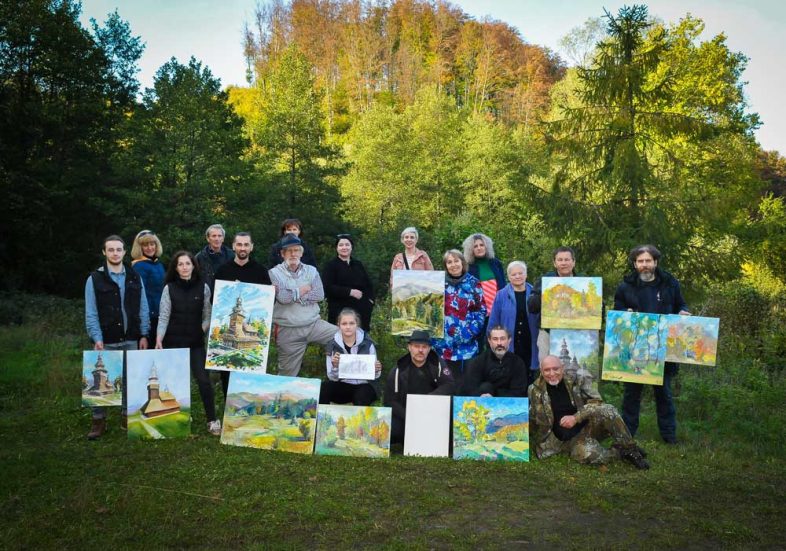Oksana Ochkurova has experienced displacement twice. In 2014, she had to leave Kadiivka with her three children, leaving behind her beloved job at the local cultural centre. Then, in 2022, her family evacuated from Starobilsk. Over eight years, she had managed to revive her cultural and community activities there, establishing two festivals and an art residency. As the invasion began, she and her team provided humanitarian aid to the Luhansk, Donetsk, and Kharkiv regions. Now, Oksana assists displaced people in Svaliava and has revitalised the art residency during evacuation. Her team showcases art across Ukraine and beyond, raising funds for the front lines.
Kadiivka — Starobilsk
Until August 2014, Oksana Ochkurova resided in her hometown of Kadiivka, previously known as Stakhanov. There, she orchestrated cultural events and grand celebrations at the local cultural centre. “Our cultural centre was a hub of activity, bustling with life. It wasn’t just a dormant building hosting occasional events; it was alive every day with people attending various clubs and amateur art groups,” she recalls.
Before the onset of the war in the East, Oksana welcomed her third son into the world. He was barely a year old when the family had to evacuate from the already occupied Kadiivka to Starobilsk. “It all began with seemingly trivial issues: overcrowded hospitals, shortages of medical supplies, and disruptions in utilities, especially critical when you have young children. So, we made the decision to relocate to territory under Ukrainian control and wait for 2–3 weeks.”
Initially, the family chose not to enrol their older children in school in Starobilsk, and Oksana was on maternity leave. “I was well aware of the cultural landscape in Starobilsk at the time, and frankly, I found it lacking. We were accustomed to a different pace of work in our city. They used to say that in Stakhanov, you work at Stakhanovite speeds. We organised an astonishing number of events and engaged numerous people. The same couldn’t be said for Starobilsk. It was a provincial town where life seemed to move at a slower pace. People were accustomed to a more leisurely way of life: tending to their gardens, minding their own affairs, and time passed by very, very slowly,” reminisces Oksana.
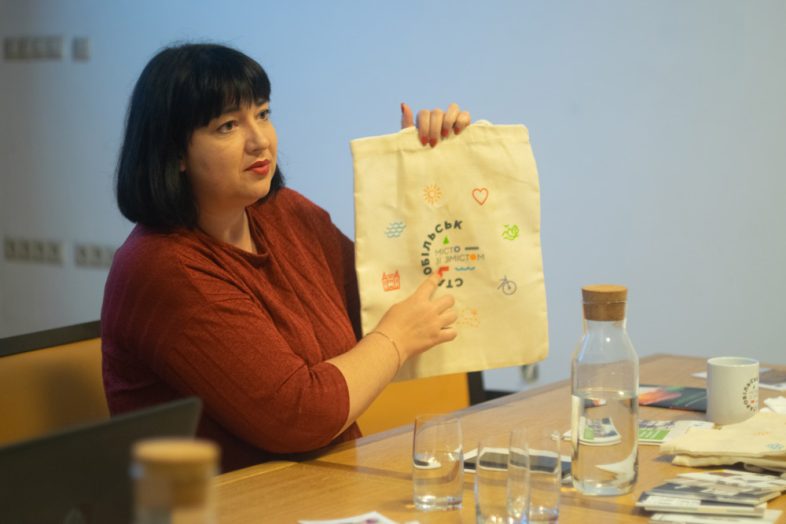
Photo: Oksana Ochkurova
Displaced persons form a volunteer group
At first, Oksana didn’t even think about getting involved in Starobilsk’s cultural scene; she was hopeful about returning home. However, during her maternity leave, she volunteered and, together with six colleagues, established an initiative group for displaced persons. “Our primary aim was to assist ourselves and our children in better integrating into the community we found ourselves in. We began meeting, getting acquainted, and launching collaborative initiatives. Initially, these efforts were met with hostility from the locals in Starobilsk. People didn’t grasp the concept of volunteering.”
As time passed, collaborative efforts to clean up the city and volunteer initiatives gained traction, with each neighbourhood in Starobilsk forming its own initiative group. By 2016, the displaced persons’ initiative group had evolved into the public organisation “Center for Joint Development ‘Active Community.'”
“For me, it’s an opportunity to be proactive and not rely solely on directives and actions from higher authorities. Within a public organisation, you have the freedom to research issues independently and address them much more effectively than government agencies might. While these structures are not directly comparable, when a public organisation identifies areas where it can collaborate effectively with authorities, the community it serves benefits greatly from such partnerships,” Oksana elaborates.
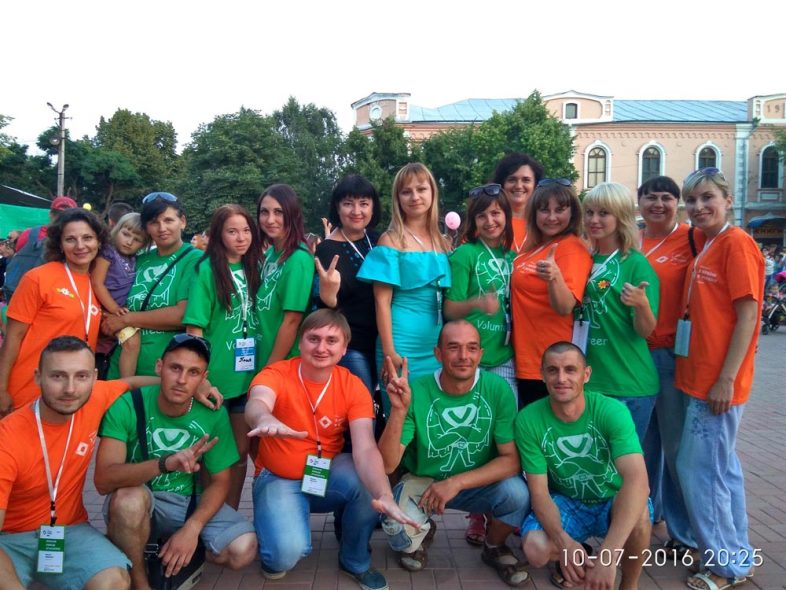
“Aura of the City” — art residency in Starobilsk
The public organisation initiated the cultural-educational festival “From Country to Ukraine” and the Sherwood Weekend bike festival in Starobilsk. In 2019, the “Aura of the City” art residency took place for the first time.
“Luhansk region was a challenge for us: would artists come to us? Is the Luhansk region interesting to people? Are we really doing the right things? We wanted to open the Luhansk region to all of Ukraine and the whole world. We wanted to show how diverse and welcoming it is and to dispel stereotypes about Luhansk and its people,” notes Oksana Ochkurova.
However, their fears were unfounded: Forty-seven artists applied for the first residency, and the organisers had to select seven. Oksana explains that the residency aimed to explore Starobilsk’s identity: “We wanted the artists, after researching the identity, to see development scenarios for this city. Paths that the city could take to reach a new level of cultural life and recognition.”
For the locals, this event was a breath of fresh air, drawing crowds eager to sit for the artists’ portraits. Following the residency, the team curated an art exhibition showcasing the works of these artists, which later travelled to Kramatorsk, Lviv, and Kyiv. Some pieces, retained by the artists themselves, found their way into solo exhibitions and other events. “It’s akin to forging neural pathways in the brain. Bonds were forged between the visiting artists and our community, now thriving independently. Our residents, for instance, actively engaged in activities at the Luhansk Regional Scientific Library and established direct connections,” Oksana elaborates.
Shortly before the full-scale Russian invasion, Oksana and her team held the last residency in Starobilsk — the Blockpost. “We focused on veteran themes, aiming to harness art as a means to mend emotional scars and support our former servicemen. It posed a challenge, though, as engaging veterans in cultural and artistic ventures proves to be quite a feat. The exhibition featuring works from this residency was slated for March 2022. As for our ‘Blockpost’ themed residency, it remained open-ended, unfinished,” Oksana recounts. Alongside her team, she embarked on research regarding the evolution of Starobilsk’s cultural landscape, culminating in the inception of a tourism brand for the city. Unfortunately, the escalation of the war prevented any further development of the community brand.
Delivering medicines to occupied Starobilsk
Oksana and her family departed Starobilsk immediately following February 24th — their possession of a car proved pivotal. They journeyed as far as they could until reaching Svaliava, where Oksana continued her volunteer efforts: “One of my colleagues remained in Starobilsk for six months; she couldn’t leave, and during that time, we assisted numerous individuals amidst the occupation. We devised a form for residents requiring costly medications in the city: those battling cancer, individuals with diabetes, and thyroid conditions. They completed the form, and we procured these medications in Ukraine, dispatching them to Starobilsk. There, they were distributed free of charge to those in need. In this manner, when the pharmacies in the occupied city ran dry, we managed to aid many individuals. Additionally, we provided food assistance.”
Right from the outset of the invasion, even en route to Transcarpathia, Oksana scouted for body armour, helmets, and other gear for the defenders. “Our organisation had a solid reputation in the Luhansk and Donetsk regions, with numerous allies and partners. There was a strong response from people, donations poured in, and we also had projects that donors permitted us to adapt. Instead of using the funds as initially planned, such as for office equipment, we began procuring medications,” she elaborates.
Bringing food there, taking people back
At the outset of the invasion, Oksana and her team conducted humanitarian missions to the Luhansk, Donetsk, and Kharkiv regions. They delivered food there and transported people back: “We took individuals to Dnipro; those who wished could disembark there, while others could continue with us to the Transcarpathian region. It wasn’t a large number, but we managed to evacuate around a hundred people this way.”
From July 2022 onwards, the public organisation resumed its office operations and established a humanitarian hub: “We reinstated the use of a Google form to gather people’s requirements. Our aim was to assist individuals from Starobilsk. Leveraging our resources, we dispatched packages to approximately a thousand individuals across Ukraine, comprising provisions, medications, and hygiene items.”
In formal terms, the humanitarian hub became part of the hubs network in the Luhansk region and reported to the Luhansk Regional Administration, although it did not receive any support from it. In Svaliava, the hub comprises 300 individuals who participate in events, and residents of the Luhansk region can also access material humanitarian aid.
“When it comes to social services and events, we don’t exclusively focus on the Luhansk region. We welcome all displaced individuals and locals requiring our assistance. Our goal is to integrate people into the community where we are currently based,” underscores Oksana Ochkurova.
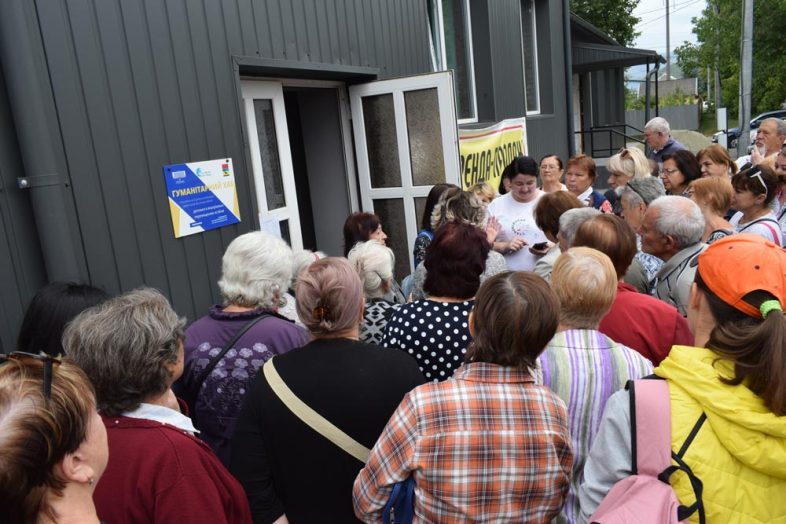
Humanitarian hubs have been opened in Svaliava and Kyiv
The hub’s activities are expanding. As part of a collaborative project, the team has established family support centres in Svaliava and Kyiv. In Kyiv, displaced individuals from the Luhansk region can access various services at the hub, including psychologists, lawyers, assistance with pension matters, employment support, and access to the Administrative Services Centre (ЦНАП). Efforts are also underway in Kyiv to establish a STEM laboratory at the hub to enhance the quality of educational services for internally displaced children.
In Svaliava, around 300 people visit the hub each month, and there’s a waiting list for children’s courses: “Svaliava shares similarities with Starobilsk. Both are former district towns in terms of population and infrastructure. There aren’t many options for people to take their children out or attend to themselves. For kids, we offer English language classes, rhythmic gymnastics, art therapy, a dedicated children’s area, psychological support, and a school readiness programme.”
Oksana and her team organise art therapy courses, movie screenings, and dialogues for adults. They have introduced a new format of interaction where they invite people to have conversations on various topics. Oksana believes that communication is essential for sharing thoughts and hearing one’s own thoughts. She sees this as an opportunity for the future, especially when there will be a need to conduct dialogues and talk to people during de-occupation. Oksana emphasises that reconciliation can only happen through dialogue.
The hub’s team organises career guidance events and offers entrepreneurship support courses. Oksana Ochkurova emphasises the importance of education and self-reliance, urging individuals to work towards self-sufficiency rather than rely solely on government aid. She mentions that some individuals who initially sought humanitarian aid are now working with the organisation.
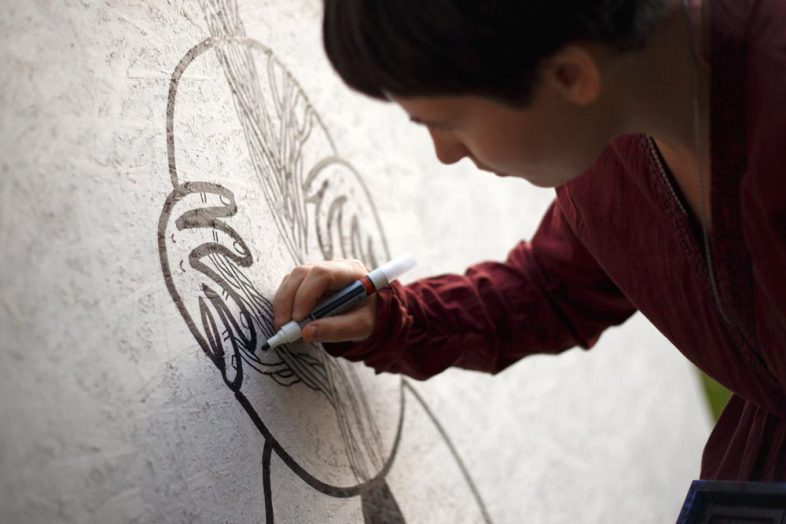
“They sold paintings to buy a quadcopter for the frontline”
The inaugural residency theme in Svaliava centred on the experiences of evacuees. “We delved into the stories of those who fled the occupation, scattering far and wide: some within Ukraine, others overseas. We shared their narratives, their struggles, their aspirations,” the volunteer elaborates.
Furthermore, the public organisation became part of the international network of Artist at Risk residencies. This initiative supports cultural figures worldwide who face various risks: “Over two months, we hosted artists: three from Kharkiv and one female artist from Kherson. We ensured their living arrangements were conducive to their creative process, providing a space free from disturbance. Three artists produced works, while the female artist used this time to replenish her energy.”
By the close of 2024, Oksana Ochkurova and her team have their sights set on rejoining the Artist at Risk residency and continuing their own residency activities. They’re even contemplating international collaboration: “In early 2023, we travelled to Slovakia and, at the invitation of the Bardějov Community Foundation, collaborated on a week-long initiative in solidarity with Ukraine alongside our Slovak allies. We hosted various events: a municipal gathering, a concert in Bardějov’s central square, discussions, workshops, and an exhibition.”
Following the week of Ukraine-support events in Slovakia, the team successfully fundraised for thermal imagers for the military. Additionally, proceeds from selling paintings from the Svalyava residency enabled them to acquire a quadcopter: “Many who purchased artworks by Ukrainian artists saw it as not just acquiring art but also investing in their own security. Culture and education should be our primary focus, especially as we envision reclaiming our territories. It’s about instilling Ukrainian identity in these regions, ensuring they don’t just bear the Ukrainian label on paper but genuinely feel like part of Ukraine, thus safeguarding them from future encroachment by any adversary claiming them as part of Russia.”
